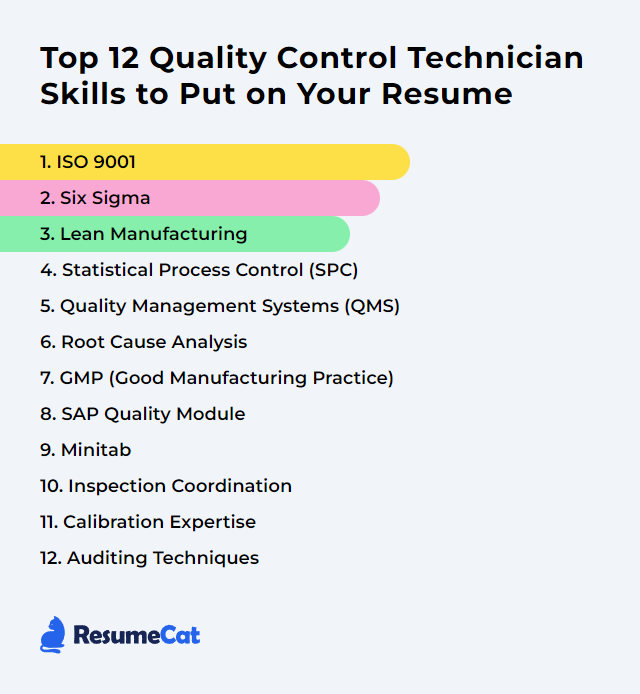Top 12 Quality Control Technician Skills to Put on Your Resume
In quality control, resumes that blend sharp technical know-how with crisp people skills tend to rise to the top. The list below spotlights a dozen capabilities every quality control technician should showcase, from standards mastery to analytical punch, with a nudge toward modern practices that employers expect today.
Quality Control Technician Skills
- ISO 9001
- Six Sigma
- Lean Manufacturing
- Statistical Process Control (SPC)
- Quality Management Systems (QMS)
- Root Cause Analysis
- GMP (Good Manufacturing Practice)
- SAP Quality Module
- Minitab
- Inspection Coordination
- Calibration Expertise
- Auditing Techniques
1. ISO 9001
ISO 9001 sets the requirements for a quality management system that drives consistency, control, and continual improvement. It’s the backbone that keeps processes disciplined and outcomes predictable.
Why It's Important
It anchors process control, cuts variation, and channels feedback into better products and services. Customer trust climbs. Waste falls. Everyone breathes easier.
How to Improve ISO 9001 Skills
To sharpen ISO 9001 as a Quality Control Technician:
Know the clauses: Translate requirements into day-to-day controls and records that actually work on the floor.
Run tight internal audits: Probe process risks, evidence, and effectiveness. Verify, don’t assume.
Use PDCA relentlessly: Plan smart, run clean, check the data, adjust without drama.
Strengthen supplier control: Clear specs, measured performance, quick containment when things wobble.
Measure what matters: Fewer KPIs, better signals. Turn trends into action.
Stay current: Be aware that ISO 9001:2015 remains active with a 2024 amendment emphasizing context and considerations such as climate-related impacts. Reflect these updates in risk and context analyses.
Embed the standard in the routine, not the shelf. That’s the trick.
How to Display ISO 9001 Skills on Your Resume
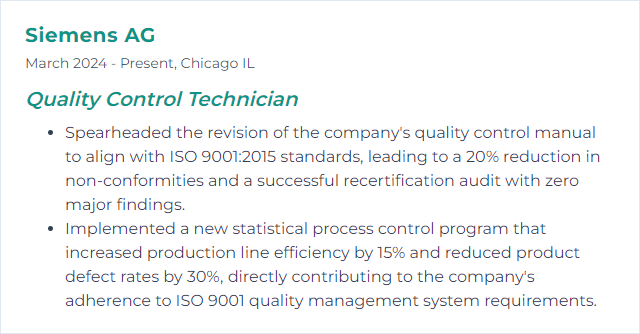
2. Six Sigma
Six Sigma is a data-first approach for driving down defects and variation using DMAIC, statistics, and disciplined project execution.
Why It's Important
It converts noise into numbers, then numbers into better yield, fewer complaints, and tighter costs. Precision over guesswork.
How to Improve Six Sigma Skills
Level up: Earn belts that match your role and run scoped DMAIC projects end to end.
Prioritize CTQs: Tie improvements directly to what customers actually value.
Use the right tools: Hypothesis testing, DOE, capability studies—apply them where they count, not everywhere.
Automate data capture: Clean inputs mean credible conclusions. Reduce manual entry where possible.
Lock in control: Sustain gains with clear control plans, visual management, and layered audits.
How to Display Six Sigma Skills on Your Resume
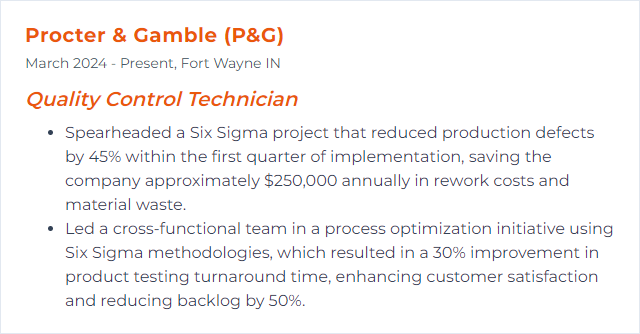
3. Lean Manufacturing
Lean strips out waste—time, motion, defects, inventory—so value flows. Quality control thrives when non-value work disappears.
Why It's Important
Less rework. Faster cycles. Fewer surprises. Customers notice the calm and the consistency.
How to Improve Lean Manufacturing Skills
Kaizen often: Small wins, piled high. Solve today’s friction, not next quarter’s fantasy.
5S the workspace: Order, shine, standards, and discipline. Clutter hides defects.
Poka‑yoke: Build in error-proofing so mistakes can’t sneak through.
Map the value stream: See the flow end to end. Tackle bottlenecks, handoffs, and queues.
Go to the gemba: Stand where the work happens. Observe before you prescribe.
Blend with Six Sigma: Lean for speed, Sigma for stability—both, not either.
How to Display Lean Manufacturing Skills on Your Resume
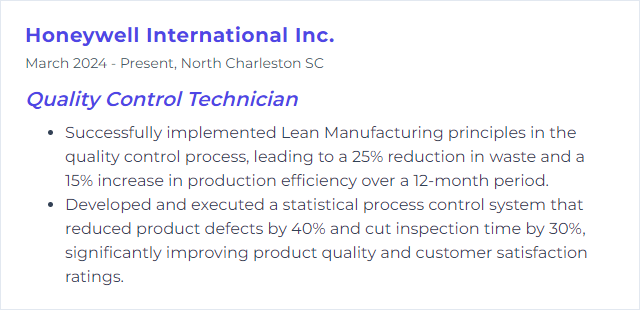
4. Statistical Process Control (SPC)
SPC uses control charts and analytics to separate common-cause hum from special-cause alarms, keeping processes inside the rails.
Why It's Important
Catch drift early. Prevent scrap before it snowballs. Stability beats heroics every time.
How to Improve Statistical Process Control (SPC) Skills
Choose charts wisely: X̄‑R, I‑MR, p, u—match the chart to data type and sampling.
Tighten data quality: Calibrated instruments, consistent sampling, clear reaction plans.
Monitor in real time: Alerts, dashboards, and rational subgrouping that actually makes sense.
Attack root causes: When signals pop, investigate fast, verify, and remove the actual cause.
Close the loop: Lock changes into SOPs, training, and preventive maintenance.
How to Display Statistical Process Control (SPC) Skills on Your Resume
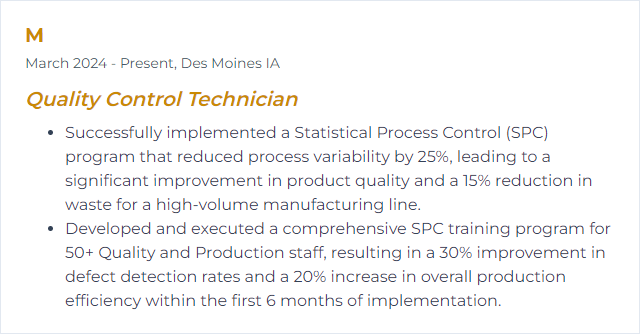
5. Quality Management Systems (QMS)
A QMS is the scaffold that holds policies, processes, records, risks, and improvements together—practical, auditable, repeatable.
Why It's Important
It aligns teams around requirements, reduces rework, and turns lessons learned into standard practice.
How to Improve Quality Management Systems (QMS) Skills
Audit with purpose: Find effectiveness gaps, not just checklist misses.
Strengthen CAPA: Evidence-based root causes, verified fixes, and measured effectiveness checks.
Digitize smartly: Use eQMS features for change control, training, and document/version control.
Integrate feedback: Voice of customer and field data should steer priorities.
Keep it lean: Trim bloated documentation. Clear, current, used.
How to Display Quality Management Systems (QMS) Skills on Your Resume
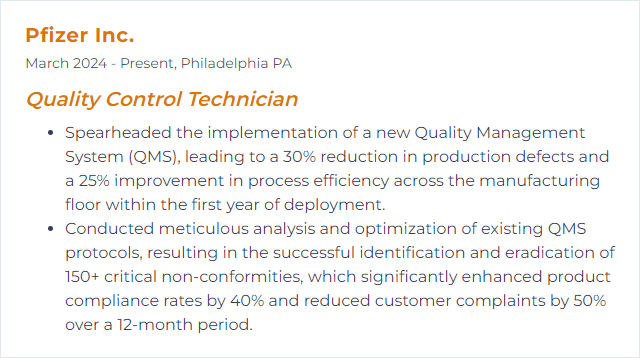
6. Root Cause Analysis
RCA hunts down the underlying cause—not the symptom—so the problem stays fixed.
Why It's Important
Permanent solutions beat band-aids. Quality rises, downtime falls, and the same fire doesn’t reignite tomorrow.
How to Improve Root Cause Analysis Skills
Frame the problem: Clear, observable, measurable. No fuzz.
Use structured tools: 5 Whys, Fishbone, fault tree, Pareto. Choose, don’t shotgun.
Collect hard evidence: Time-stamped data, photos, samples, logs. Opinions last.
Validate the cause: Prove linkage with tests or trials before rolling fixes plant-wide.
Prevent recurrence: Update SOPs, training, controls, and FMEAs to keep it closed.
How to Display Root Cause Analysis Skills on Your Resume

7. GMP (Good Manufacturing Practice)
GMP codifies how products are made, controlled, and documented to protect patients and consumers. Think identity, strength, quality, purity—and data integrity throughout (ALCOA+).
Why It's Important
It minimizes contamination, mix-ups, and errors. Safety isn’t negotiable, and compliance keeps doors open.
How to Improve GMP (Good Manufacturing Practice) Skills
Train continuously: Role-based, refreshers, and effectiveness checks—not just sign-offs.
Elevate documentation: Clear batch records, contemporaneous entries, tight change control.
Maintain with rigor: Calibrations, PM schedules, and validated states kept current.
Toughen QC release: Risk-based sampling, trending, and review by exception where appropriate.
Strengthen data integrity: Audit trails, access controls, and periodic reviews of electronic systems.
Close the feedback loop: Deviations to CAPA to learning to prevention—fast.
How to Display GMP (Good Manufacturing Practice) Skills on Your Resume
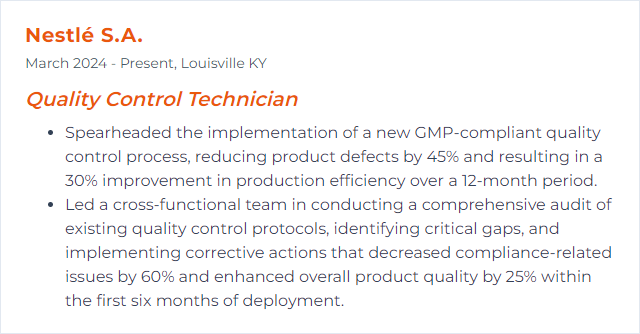
8. SAP Quality Module
SAP QM (in ECC or S/4HANA) manages inspection plans, in-process checks, results recording, quality notifications, and integration with procurement and production.
Why It's Important
It connects master data to execution, speeds containment, and turns quality data into action. Traceability, embedded.
How to Improve SAP Quality Module Skills
Clean master data: Materials, characteristics, specs, sampling procedures—accurate and governed.
Automate routine: Auto-trigger inspections, certificate creation, and usage decisions where rules allow.
Use notifications: Log defects and complaints, route tasks, and track closures with SLA discipline.
Leverage analytics: Build KPIs and dashboards; in S/4HANA, use embedded analytics for real-time views.
Integrate upstream/downstream: Tie QM to procurement, production, EWM, and vendor evaluation.
Practice in a sandbox: Test processes, roles, and authorizations before go-live changes.
How to Display SAP Quality Module Skills on Your Resume

9. Minitab
Minitab packs control charts, capability analysis, DOE, regression, and more—quickly turning shop-floor data into decisions.
Why It's Important
It shortens the path from hypothesis to proof. Better calls, made faster.
How to Improve Minitab Skills
Refresh the stats: Distributions, confidence intervals, power, nonparametrics—know when to use which.
Focus on core tools: Control charts, capability, GR&R, DOE. Depth beats breadth.
Use real datasets: Practice with your process data; simulate when needed to stress-test methods.
Template your work: Standard worksheets and macros for repeat analyses save time and errors.
Tell the story: Clean graphs, plain language, clear recommendations. Analysis that moves people.
How to Display Minitab Skills on Your Resume
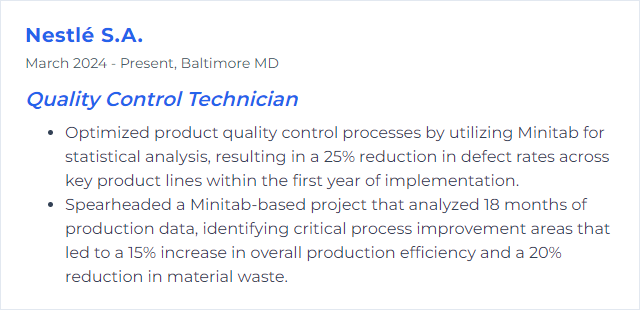
10. Inspection Coordination
Inspection coordination choreographs standards, schedules, tools, and talent so every check lands on time with the right rigor.
Why It's Important
Missed or messy inspections let defects slip. Tight coordination catches them early, cheaply.
How to Improve Inspection Coordination Skills
Standardize: Clear methods, calibrated gauges, unambiguous accept/reject criteria.
Plan the cadence: Risk-based frequencies, line readiness checks, and pre-inspection reviews.
Digitize collection: Electronic checklists, photo evidence, time stamps, instant escalation.
Communicate crisply: Daily huddles, visible boards, and single-point ownership for issues.
Adopt modern aids: Vision systems, AI-assisted defect detection, and inline sensors where justified.
Close with a review: Trend findings, remove recurring pain, and update control plans.
How to Display Inspection Coordination Skills on Your Resume
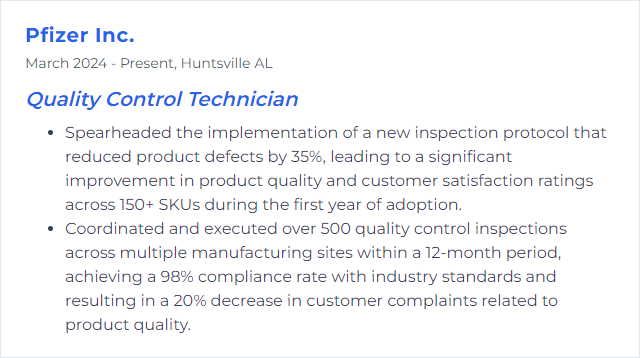
11. Calibration Expertise
Calibration expertise ensures instruments match known standards, traceably, so measurements can be trusted.
Why It's Important
Bad measurements poison decisions. Accurate, reliable gauges keep specs meaningful and results defensible.
How to Improve Calibration Expertise Skills
Strengthen metrology basics: Uncertainty, traceability, tolerances, and environmental effects.
Follow standards: Align to recognized calibration and lab competence requirements (such as ISO/IEC 17025 principles where applicable).
Document rigorously: As‑found/as‑left, out‑of‑tolerance impact assessments, and clear labels.
Use software: Calibration management systems for schedules, certificates, and reminders.
Practice hands-on: Work across instrument families—pressure, temperature, mass, electrical—to broaden range.
How to Display Calibration Expertise Skills on Your Resume
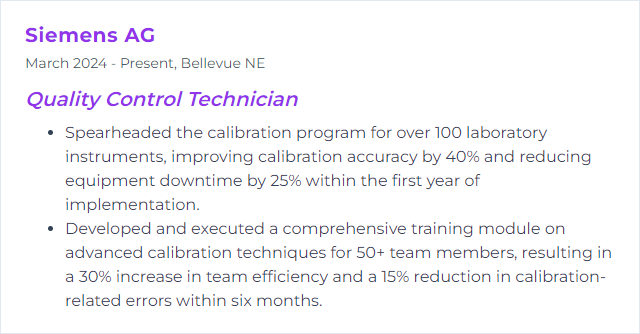
12. Auditing Techniques
Auditing techniques verify that processes, people, and records match policy and reality. They test effectiveness, not just existence.
Why It's Important
Audits uncover blind spots, confirm compliance, and spark targeted improvements before regulators or customers do.
How to Improve Auditing Techniques Skills
Risk-based plans: Aim deeper where the risk is higher. Sample smart.
Evidence-focused: Objective records, observed practices, and interviews that go beyond the script.
Write sharp findings: Clear criteria, facts, and impact—then pragmatic, time-bound actions.
Use audit software: Plan, capture, track actions, and trend systemic issues.
Hone people skills: Neutral tone, probing questions, and calm conflict handling.
How to Display Auditing Techniques Skills on Your Resume

